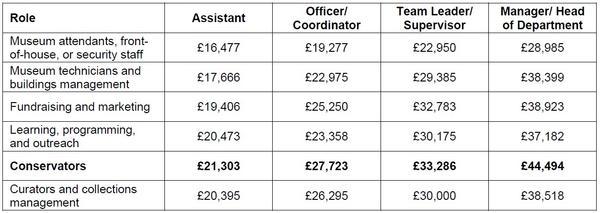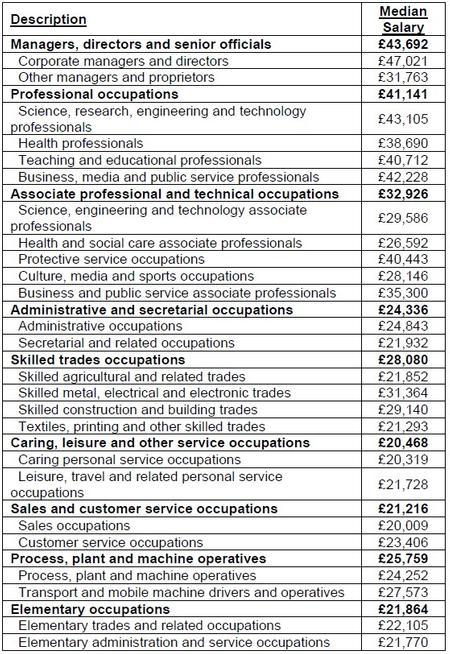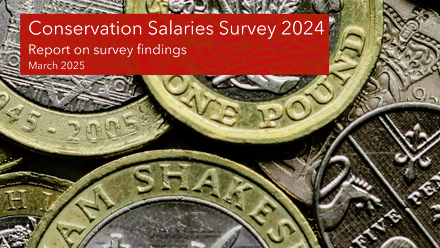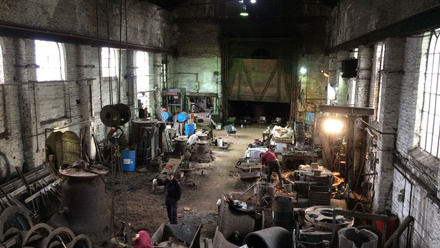Icon Salaries Roundtable: Advocating for fair pay across the conservation profession
Overview
Icon is committed to supporting professional conservators in subjects that matter to them – salaries and remuneration levels invariably come towards the top of the list of topics on which members want to see Icon taking action. Years of wage stagnation compounded by the current cost-of-living crisis have made this a pressing issue for many in the sector.
Icon is a charity and professional body rather than a trade union, and as such we have limited ability to influence the job market or employment practices. However, what we can do is provide the data and tools to support others to drive change.
Gathering reliable data was the starting point of this exercise Icon undertook our Salaries Survey in early 2022 to help us better understand the true picture of salary levels across the sector. Among other findings, this survey showed us that the average salary for professional conservators was £31,814 – the typical professional earning this salary is likely to hold a master’s degree and have over 11 years professional experience in Conservation. It is clear that members feel that this figure does not reflect the high level of technical skill, training and expertise that is required to work as a professional conservator and that action is needed to support calls for fair pay across the sector.
To delve deeper into this issue, Icon convened a roundtable discussion on 21st July 2022. The event brought together practitioners from across the conservation profession alongside representatives from Prospect and Fair Museum Jobs to consider the report and identify the key actions necessary to support professionals advocate for change.
Conservators are not alone
Low pay levels are widely recognised as being an issue for all parts of the heritage sector, not just for conservation professionals. Office for National Statistics (ONS) data shows that the median salary across the UK is £31,722 (ONS, 2021) – this compares to £31,285 for heritage workers (Prospect, 2022) and £30,500 for conservators (3.8% below the national average, and 2.5% below the heritage sector average).
Advocacy efforts are needed to dispel unhelpful and inappropriate narratives which work to undermine the impact of these messages. For example, we know that heritage workers are often seen as ‘lucky’ to work in the sector or that the profession is described as a vocation. These ideas are troublesome, in that they are often used as a way of compensating workers for low levels of pay which are endemic in the sector as a whole.
As well as falling below the national average, there is a common perception that conservators’ salaries often fall below those of similarly qualified museum professionals such as curators. However, the Museums Association 2017 Salary Guidance report - the most recent sector wide report on salary levels across the museum sector - in fact showed that conservation professionals had the highest earners of non-director roles in each of the role levels that were identified through the survey.

Average Salary Levels, Museums Association 2017
While conservation job roles might come at the top within the Museums Association survey, we are aware that this is not always the case across all employers. This also does not imply that the salary levels for professional conservators, alongside other heritage professionals are fair and proportionate to the high level of technical skill and depth underpinning knowledge which is required to undertake roles in the sector.
Turning to the average salary levels by ONS top level Standard Occupancy Classifications (SOC) we can see that conservation salaries are placed in the ‘Associate professional and technical’ occupations category – however we might quite reasonably expect them to be classed alongside ‘Professional Occupations’. To help understand how a change to this designation might be achieved it is helpful to consider those occupations that already fit within the ‘Professional occupations’ category.

Mean salary level by role, ONS 2021
Turning to the average salary levels by ONS top level Standard Occupancy Classifications (SOC) we can see that conservation salaries are placed in the ‘Associate professional and technical’ occupations category – however we might quite reasonably expect them to be classed alongside ‘Professional Occupations’. To help understand how a change to this designation might be achieved it is helpful to consider those occupations that already fit within the ‘Professional occupations’ category.
Architecture is regularly cited as a good comparison to the conservation profession in terms of levels of training, skills, and responsibility. The Royal Institute of British Architects (RIBA) ‘Salary Guide 2022’ showed that mean salaries for Architects with over 5 years’ experience was £40,000 compared to £34,000 for those with less experience. Similar assessments of the salary levels for conservators shows median salary levels of £25,217 and £32,020 respectively.
So, what is the reason for this variance? Whilst there is clearly common ground between the length and level of professional training and the depth of underpinning knowledge required to practice as a conservator and an architect, there are several key differences in the professions.
The two professions operate in different regulatory environments. Architects are legally required to be registered with the ARB in order to practice in the UK, however there is no such regulatory requirement for conservation professionals. Icon Accreditation is well placed to offer similar levels of reassurance and external validation of professional practice; however, we know that it needs to grow in order to be effective.
Whilst formal regulation of the conservation profession is highly unlikely, there is work that can be done in order to drive the demand for independently validated professional skills, which may make it easier for professionals to feel confident in asking for a fair level of pay. Icon Accreditation offers a natural focus for that activity and Icon should continue to ensure that it is an open and accessible process to ensure that all who want to go through the process are able to.
Another issue that that has been highlighted is a lack of opportunity for progression within the conservation profession and the way in which gaining new skills and taking on additional responsibilities are rewarded. The sector is relatively small, and so inevitably there are going to be less opportunities to take on higher paid senior roles in the first place – these are also likely to take people away from the bench and the collections that attracted many into the sector in the first place.
We know from the Conservation Salaries Survey, that in spite of the high level of technical training (and associated cost) that is required to develop an individual’s underpinning knowledge and technical conservation skills, that there is little financial reward associated with those skills. Indeed, the survey showed that the majority of jobs in the sector require at least a good understanding of one’s discipline and area of practice. However, broader professional skills such as people management and financial responsibility do have a greater impact on pay and remuneration, as they do in other professions. Within the conservation sector these types of responsibilities are rarely present in a meaningful way in the role descriptions of early and mid-career professionals.
Turning again to Architecture as a point of comparison; we know that even at a relatively early career stage, Architects are likely to have greater financial and legal responsibilities as part of their day-to-day work given the nature of their projects. At the same time, senior professionals within the architecture profession are likely to be able to command higher salary levels, not only because they might manage a team of people, but also because of the respect and value placed in their well-developed technical practice and a track record of highly visible and high-value projects.
Demonstrating value and impact to decision makers
Icon’s recently launched Strategy sets out our aim to achieve wider recognition of the value that conservation brings to society - advocating for fair levels of remuneration across the sector is one aspect this work. To achieve this, Icon needs to work with partners including allied professional bodies, employers, and national heritage agencies.
If the conservation profession is to be seen as a professional occupation rather than an “associate professional and technical occupation”, then the sector needs to work hard to demonstrate the cultural and social value of conservation, and to promote the positive outcomes that conservators deliver through utilising their highly developed technical skills and understanding of conservation.
Advocacy efforts need to be built on a robust case, built not only around the idea of value and fairness, but also on the tangible economic benefits that a highly skilled conservation profession brings to society. For example, the economic impact of conservation in terms of attracting visitors and generating income.
The efforts need to focus on real changes which will have a material impact on the conservation workforce. For example, long term funding commitments for the national institutions from the Department for Culture, Media and Sport would allow organisations to more effectively plan their workforce requirements allowing greater stability in employment practices across the sector.
Action needed to revise Icon’s salary benchmarks
Icon has provided salary benchmarks for entry level conservation jobs since 2008 when the first minimum recommendation was set at £20,895. Members value this information, however there is a desire for further work to be done to update this figures that are presented.
The initial information was updated in 2014 to £24,648 and again in 2019 to £27,108 in line with the consumer price index. If those figures were updated today the minimum entry level salary would be £30,230 – a similar rate to the current median salary level for all conservation job roles, and significantly higher than the current average for early career conservation professionals.

Average salary levels by Job role / level 2007 and 2022
The figures above compare the mean average salaries of a review of job adverts placed with Icon in 2007 to the findings of the 2022 salaries survey. Generally, the variance in salaries is minimal, with between 3 and 18% increase on the salary levels shown for the different levels of positions.
When developing the original recommendation in 2008, discussions took place as to whether recommendations should be developed for a range of levels of job roles. Given the challenges in finding common ground across different job titles across the sector that work was put aside in favour of an entry level recommendation.
However, it is clear that there is significant appetite for new benchmarks that go beyond an entry level minimum salary level. Icon will base the new set of benchmarks on the methodology used within the Salaries Survey, which assessed job roles against four factors: underpinning knowledge & skills of conservation practice, people management, decision making, and financial responsibility. Benchmarks must also be realistic – recommendations that are out of step with department staffing budgets are likely to be ignored and so have limited impact.
Variance in employment practices
It is recognised that the nature of conservators’ contracts has changed, with a greater number of fixed term contracts rather than open-ended contracts. This is not a new development, however long term public sector funding restrictions budgets and associate recruitment freezes mean that many employers are unable to commit to increasing their overall staffing number and so are forced to rely on bringing in staff on fixed term and variable hours contracts to meet the demands of their conservation needs; be they to treat individual objects or for longer term projects such as the decant from Blyth House which has involved staff at the British Museum, Science Museum Group and the Victoria & Albert Museum.

Within conservation, 10% of workers are employed under fixed term contracts, including 2% who are on zero hours contracts.
Zero hours contracts are a more recent development and there is a fear that, if used improperly, they could penalise workers, leading to a loss of future work without a route for any recourse; this has been of particular concern in the retail and hospitality sectors. In 2015 the Government tightened up the rules surrounding their use to limit exclusivity clauses. Further regulation, such the option to move to a more stable contracts after 26 weeks work, is expected to be included as part of the 2022 Employment Bill. However, given the omission of the bill in the Queen’s Speech on 10th May 2022, it is uncertain whether the proposals will be progressed.
In spite of employee concerns about the use of such contracts, as a tool of employment in themselves they are not necessarily bad. We recognise that the majority of conservation sector employers using such contracts are doing so because they represent the best way of balancing the needs of their collections and their fixed budgets. It is also important to note that their flexibility works very well for many workers, allowing them to fit in short periods of paid employment around other personal and work-related commitments.
However, concerns about such contracts are valid when they are used as a form of employment for roles that really should be fixed term or open-ended employment contracts. In addition, salary levels should still respect recommended salary guidelines, and indeed there is a compelling case that the rates of pay should be higher to reflect the uncertainty over their use.
The issue of zero hours contracts clearly links to wider issues in the conservation sector, namely the lack of employment opportunities and highly competitive job market, leading many to apply for and take roles that do not suit them. Accepting that individuals must earn an income, it would be inappropriate to encourage members not to apply for or accept positions that fall below Icon’s recommendations. Instead, Icon can and should continue to support professionals in developing their skills, ensuring they have the skills to apply for the types of employment opportunities that do suit them. Icon should also offer advice on the appropriate use of zero hours contracts, producing guidance that can support the development of ‘good’ opportunities that meet our minimum guidelines. Furthermore, Icon’s revised salary benchmarks should provide recommendations for hourly rates that compensate workers for the uncertainty of fixed term and zero hours contracts (as with many interim positions in other parts of the economy).
What about freelancers?
It is clear that Icon’s salary benchmarking can and should provide advice for those on fixed term or open-ended contracts. We also endeavour to support freelance professionals in ensuring that they are able to charge rates that are commensurate with their high level of skill and experience. However, there is understandable concern as to whether advice on hourly rates for private work and individual treatments / projects could have the unintended impact of driving down the rates that individuals can charge. As such, whilst it would not be appropriate for Icon to publish minimum hourly rates, it will actively seek to support professionals in developing their own pricing structure which supports the raising of standards across the conservation profession.
The ways in which jobs are constructed and advertised
Job descriptions are also perceived to be a problem. This is seen as a particular issue in the public sector where HR systems, such as the HERA system (Higher Education Role Analysis), are used in the grading of job roles. If implemented too narrowly and not reviewed, they can easily result in the mis-grading of job roles or lead to a discrepancy in the pay levels of similar roles across an individual institution.
This is compounded when role descriptions are written in a way that doesn’t accurately reflect the true level of responsibilities within a job role. This is not to imply that those writing role descriptions are actively downplaying roles in order to drive down salary costs. It is likely that operating within these rigid structures, issues such as the choice of particular verbs to describe a role can have a significant impact on where a role will be placed within the grading structure. Icon will work to support those preparing role descriptions, by developing guidance such as model job descriptions, which will be available to all on our website.
Icon also fully supports the work of Fair Museum Jobs (FMJ), and their excellent work in campaigning for change in the ways that jobs are both constructed and advertised across the heritage sector. The FMJ Manifesto highlights a number of issues which work to limit both pay and access. For example, ‘salary secrecy’, and the practice of advertising salaries as ‘competitive’ create opacity across the job market. FMJ also highlights other issues, such as the practice of including qualification requirements which aren’t necessary to perform a job role, as being significant in creating unequal access for the heritage labour force.
Next steps and driving change
There are indications that conservators are starting to ‘speak with their feet’. Anecdotal feedback suggests that employers are regularly struggling to fill vacancies, and it is very likely that salary levels are a key reason for low numbers of job applications being received. Without change there is a real risk of a skills shortage across the conservation profession, as individuals seeking a stable and comfortable income are left with little option but seek employment opportunities elsewhere.
As we’ve noted consistently through this work, collaborative working with individuals, employers, commissioners and sector partners is needed to drive effective change. Actions suggested include:
1) Revised Salary Benchmarking
Icon will publish salary benchmarks for early career, mid-career, and senior level positions. These will be based on the median salary levels identified through Icon’s salary survey and will be pitched against an individual’s responsibility related to knowledge of discipline, decision making, people management and financial responsibility. The banner placed on job adverts which fall below Icon’s benchmarking will also be updated.
The benchmarking will be updated every two years based on a survey of professional conservators.
2) Build Economic Case
As far as we can, we need to link the cultural and social value of conservation to the direct economic impact of conservation. This should be backed up by continued research, such as Icon’s salaries survey and annual reporting from Icon’s Job Advertising service, to ensure that we have accurate and reliable data on which to base our advocacy efforts.
3) Clear and accessible guidance and support for individuals
Icon is committed to making its data and research available on our website to enable individuals to use this as part of their own salary negotiations. As well data, Icon should seek to develop resources such as draft role descriptions and provide links to best practice employment guidance. This suite of support should be supplemented by an enhanced suite of training courses, such as an introduction to HR for conservation professionals and a broader range of business development programmes.
4) Encourage conservators to work with Unions
Icon will encourage individuals to actively participate in helping to improve pay and remuneration levels across the sector, be it supporting the excellent work of advocacy groups such as Fair Museum Jobs or through seeking out efforts to work collaboratively to drive change. Icon strongly supports the work of unions such as Prospect and would encourage members to work with established groups to raise challenges and make the most of the support available to them in order to improve their pay and working conditions.
Event Report: Icon Salaries Roundtable: Advocating for fair pay across the conservation profession






